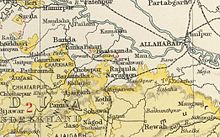Bhaisunda, also spelt 'Bhaisaunda', was a princely state in India during the British Raj.
History
Bhaisaunda state was founded in 1812 by the Kalinjar family.
It was one of the Chaube Jagirs, which were part of the Bagelkhand Agency of British India.
Practically all the inhabitants of the Jagir were Hindu.[1] The capital was the village of Bhaisunda, located at 25° 18′ N, 80° 48′ E..
In 1948, one year after Indian independence, Bhaisunda was merged into the Indian state of Vindhya Pradesh.
Rulers
The rulers of Bhaisunda were titled 'Chaube' and from 1885, 'Rao Chaube'.[2]
Chaubes
- 1812 - 1829 Newal Kishor (d. 1829)
- 1829 - 18.. Acharju Sing (b. c.1819 - d. ... )
- 1829 - 1840 Zirat Prasad -Regent
- 1840? - 10 Oct 1885 Tirath Prasad (b. 1822 - d. 1885)
Rao Chaubes
- 10 Oct 1885 - 8 Jan 1916 Chhatarsal Prasad (b. 1877 - d. 1916)
- 10 Oct 1885 - 1896 ... -Regent
- 8 Jan 1916 - 4 Nov 1916 Bharat Prasad (b. 1884 - d. 1916)
- 4 Nov 1916 - 1947 Govind Prasad (b. 1884 - d. af.1948)

